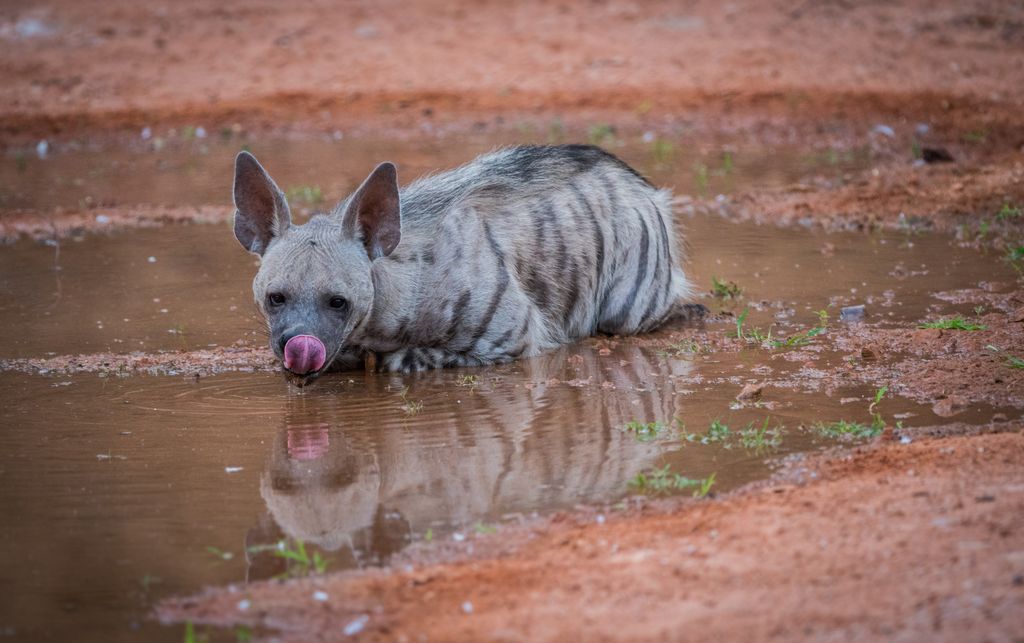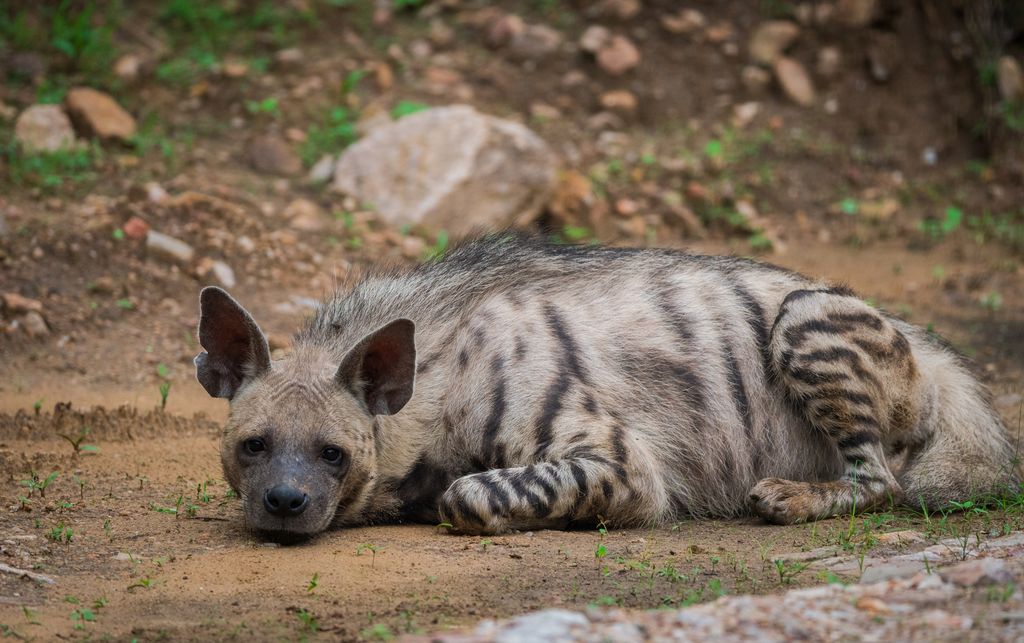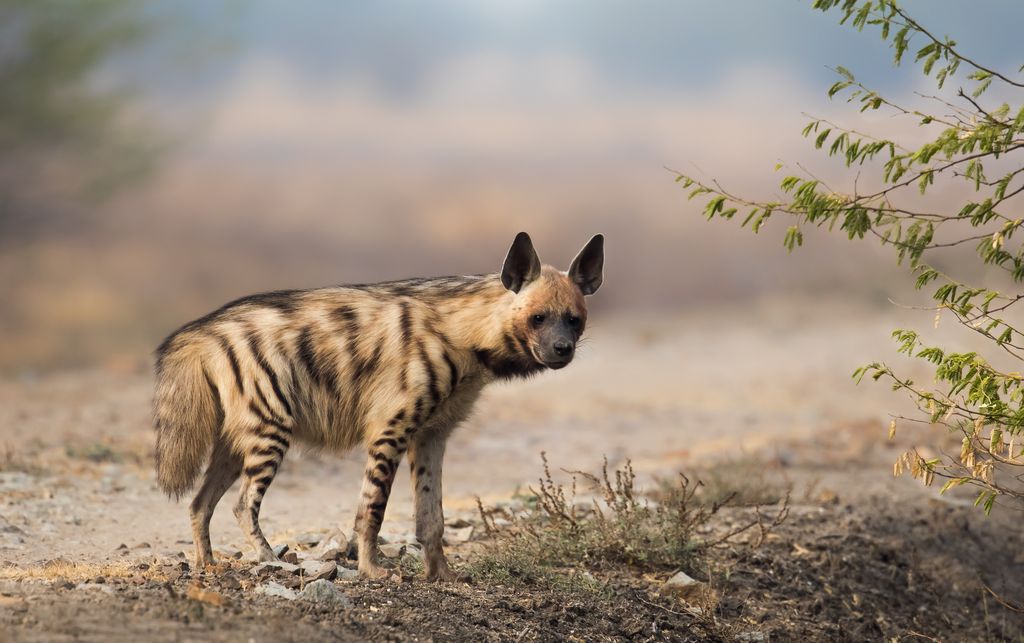An animal that emits sounds similar to human laughter but it’s not a human, an animal adorned with stripes yet distinct from a tiger, an animal possessing a muzzle resembling that of a dog but unrelated to the canine family, and an animal so unique that an entire family is designated specifically for them. Yes, we are referring to the striped hyena, whose habitat spans from the Africa, Middle East to South Asia. Hyenas worldwide belong to the family Hyaenidae, exclusively designated due to the distinctive traits inherent in the members of this group.
There are four distinct species of hyenas found globally, with the Aardwolf being the smallest and the Spotted Hyena the largest. Brown hyenas and Striped Hyenas fall within an average size range. The craniodental morphology of the top three hyenas is adapted for bone-cracking, which accounts for their possession of one of the strongest jaws in the animal kingdom. They primarily scavenge and feed on carcasses left by large cats within their distributional range. Meanwhile, the Aardwolf, the sole surviving member of the sub-family Protelinae, specializes in feeding on termites.
Despite their canine-like appearance, hyenas are more closely related to cats. All hyenas possess four digits on both their forelimbs and hindlimbs, except for the Aardwolf, which has five digits on its forelimbs.
Conservation Status:
Despite their widespread distribution and adaptability to survive in landscapes dominated by humans, Striped Hyenas are currently facing conservation challenges. They have been classified as Near Threatened by the IUCN (International Union for Conservation of Nature). The estimated global population of Striped Hyenas ranges between 5000-9999, and unfortunately, this population is declining.
In India, the Wildlife Protection Act categorizes them under schedule III, which prohibits their hunting or killing. Any violation of this order incurs a penalty.
Distribution and Habitat preference of Hyenas in India:

The Striped Hyena’s habitat in India spans across the Terai belt, located to the south of the Shivalik range, and covers a significant portion of Peninsular India, as well as arid and semi-arid regions in Western India. These animals are well adapted to dry environments; however, they are rarely sighted in areas experiencing high rainfall, such as the Western Ghats and parts of North-Eastern India. Additionally, they tend to avoid coastal and desert regions.
Across most of their Indian range, hyenas are found in fragmented populations with low densities. This fragmented distribution renders them susceptible to local extinctions. The combination of their nocturnal habits and coexistence with humans further complicates efforts to accurately assess their true distribution and population numbers.
The majority of India’s hyena population resides outside of protected areas, primarily inhabiting human-dominated agro-pastoral landscapes in semi-arid regions. They exhibit a preference for habitats characterized by undulating hills, rocky outcrops, ravines, and limestone caverns. Significant numbers of hyenas thrive in semi-arid landscapes abundant with large livestock populations, such as the Deccan plateau, Kachchh, and portions of Rajasthan and Madhya Pradesh.
These creatures frequently venture into human settlements during the night, seeking food. They typically navigate through gullies, riverbeds, and streams adorned with rocks or vegetation cover, effectively utilizing these pathways as nocturnal thoroughfares. Their inclination towards nocturnal life is influenced by their proximity to human habitation and areas inhabited by larger feline species.
Ecology and Behavior:

Feeding:
Although striped hyenas primarily scavenge, they also engage in hunting activities, targeting small and medium-sized mammals as well as domestic livestock. Within the Indian subcontinent, they occasionally prey on animals such as hares, gazelles, jackals, nilgai calves, and wild boars. Surprisingly, reports also indicate instances of them feeding on melon and cucumber crops.
In forested ecosystems, hyenas rely heavily on ungulate carcasses left behind by tigers, leopards, and lions after predation. However, in landscapes dominated by humans, their diet largely centers around the carcasses of domestic livestock. Often, they are the last scavengers to feed on carcasses, following vultures, dogs, and jackals. Typically, they are left with only long bones and some tendons from these carcasses. Hyenas possess the ability to crack these long bones to access the nutritious bone marrow, consuming large bone fragments, portions of which they can digest.
Dr. Jhala’s study conducted in Kachchh revealed that cattle and dogs constituted over 70 percent of the hyena’s diet in that region. Furthermore, a study conducted by the Zoological Survey of India and the Forest Department of West Bengal in the Chhota Nagpur plateau, a small biogeographic province of the Deccan Peninsula, discovered that while wolves and hyenas coexist as carnivores in human-dominated landscapes, hyenas rely significantly on the kills made by wolves and feed on the resulting carcasses.
Social Beahviour:
A radio telemetry study conducted by Dr. Jhala highlighted the intricate social structure of the striped hyena, which revolves primarily around the females and their offspring. It was observed that younger females play a crucial role as helpers within the community, aiding mothers in babysitting duties and procuring food for both the cubs and lactating females. Within these hyena colonies, there exists a designated nursery den where cubs of varying ages reside, cared for by these babysitters. These assisting young females are likely related to the families, often siblings from previous litters or sisters of the mother. Unlike wolves, multiple females in a colony may give birth to offspring.
In contrast, male hyenas tend to have a more peripheral role in the rearing of cubs and rarely participate in such activities. Many males exhibit nomadic behavior, traversing areas encompassing multiple colonies, while others establish territories and confine their movements to the range of a single colony.
Striped hyenas utilize feces, urine, and anal gland secretions for scent marking. The dens’ vicinity in dry gullies serves as the site for depositing bulkier scats resulting from a meat-based diet, often at marked ‘flag posts’. Over time, these accumulations form dung piles. When threatened by intruders near their dens, hyenas employ vocalizations to defend their territory.
Reproduction:
There is limited information available regarding the reproductive behavior of striped hyenas in India. These hyenas have a year-round reproductive cycle, with a peak in births occurring during the winter months. Typically, between one to four cubs (referred to as such because of their closer relation to the cat family) are born in a designated natal den.
Similar to other carnivores, the cubs are born blind and their eyes usually open around the seventh or eighth day after birth. Teeth start to emerge approximately 21 days after birth, and the cubs start consuming meat at around one month old. Within the natal and nursery dens, there are often remnants of bones, hides, skulls, hooves, and horns brought in either by helper females or by the father. These remains serve as playthings for the cubs, who engage in play both with these food remnants and with each other.
Ecosystem Services:
Hyenas are known to scavenge on the carcasses of livestock. They are often found near the dumping ground of village dead livstock. In this way they help to get rid of the carcasses and save the disposal costs of carcass and help to check the diseases borne out of rotten carcasses. In a syudy conducted in Rajastan’s Sawai Man Singh Sanctuary, it is found that gobbled up 23 tons of livestock carcasses and 17 tons of wild prey every year, during the study period 2019 to 2020, saving thousands of dollars in carcass removal costs through electrical cremation or pyre burning. The study is one of the first estimations of monetary benefits from scavenging by striped hyenas in a human-dominated landscape.
According to the professor Randeep Singh of Amity University who conducted this study, “We found that striped hyenas are removing a vast number of livestock and wild prey carcasses, which not only helps reduce the risk of disease transmission and maintains the overall cleanliness of the environment but also, saves artificial carcass disposal costs,”.
Conservation Challenges:
Retaliatory killing by local communities poses a significant conservation challenge for striped hyenas. They are often perceived as cattle lifters, leading people to resort to lethal measures such as beating them or poisoning carcasses to eliminate them. There are reports of hyenas raiding graves, taking away children, and occasionally attacking adults sleeping outdoors. However, confirmed instances of these events are exceedingly rare. At times, due to mistaken identity—confusing hyena dens for wolf dens—villagers barricade these dens with stones and thorns, resulting in the deaths of young cubs or even adult hyenas. There are also reports of hyenas being chased, cornered, and killed by villagers, often aided by village dogs.
This negative human animal interaction and subsequent conflicts underline the urgent need for raising awareness and educating local communities about the vital ecological role played by hyenas. It’s crucial to promote understanding about the services these animals provide and implement strategies to mitigate conflicts and reduce negative interactions between hyenas and humans. Such efforts are pivotal for the conservation of this species in India.
Best places in India to See Striped Hyenas:

As a prominent top carnivore inhabiting arid and semi-arid ecosystems within Indian protected areas, striped hyenas hold a special allure for tourists. While they are nocturnal creatures and their sightings are relatively infrequent, they remain a sought-after species during wildlife safaris in India. In specific protected areas like Ranthambore Tiger Reserve, Sariska Tiger Reserve, Velavadar National Park, and Kumbhalgarh Wildlife Sanctuary, there are higher chances of spotting these elusive creatures.
Encountering striped hyenas during a wildlife safari in India is often a matter of chance, given their nocturnal habits. However, when tourists do have the opportunity to witness these animals in their natural habitat, it is greatly valued and appreciated. The rarity of sightings adds to the appeal, making a hyena sighting a notable and memorable experience for wildlife enthusiasts exploring these protected areas.

